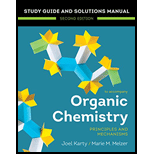
Concept explainers
(a)
Interpretation:
The product of
Concept introduction:
Deuterium
(b)
Interpretation:
The product of
Concept introduction:
Deuterium
Trending nowThis is a popular solution!

Chapter 8 Solutions
EBK ORGANIC CHEMISTRY: PRINCIPLES AND M
- Will each of the following reactions follow an El or E2 mechanism? to to HO,arrow_forward1. Draw the complete, detailed mechanism (including curved arrows) for the following reaction occurring via (a) an Sn2 mechanism and (b) an Sn1 mechanism. Pay attention to stereochemistry. KBrarrow_forwardDraw the structure of product, substrate, or condition in the following reactions (should clearly show the stereochemistry).arrow_forward
- Draw the curved arrow notation to account for the bimolecular elimination (E2) step depicted below. 2nd attemptarrow_forwardPredict the major products of each of the following reactions. Draw the complete detailed mechanism that leads to the formation of these products. Letters D and Earrow_forwardWhich reaction in each of the following pairs would you expect to be faster? (i) Write both reactions using bond-line presentation and, using arrows providing a mechanistic explanation of the course of the reaction, draw either a transition state or an intermediate product of the reaction; (ii) Shortly (one sentence) explain your reasoning why one of the two reactions will be faster.arrow_forward
- A student found that heating any one of the isomers shown here resulted in scrambling of the deuterium to all three positions on the five-membered ring. Propose a mechanism to account for this observation.arrow_forwardUpon oxidation, phenols are transformed to p-benzoquinone, which can undergo a cycloaddition reaction with a diene to make (1). After acidic workup with HCl, a tautomerization transforms the product back to a phenol derivative (2). Draw the complete, detailed mechanism of p-benzoquinone to (1) and the mechanism from (1) to (2). please explain!arrow_forward(SYN) For each of these compounds, draw an alkyl halide that can be used to produce it in an SN1 reaction. Then, determine whether the alkyl halide would need to (a) ОН (b) be treated with water or methanol and draw the OCH3 corresponding mechanism.arrow_forward
- (A) Which is an alkyl iodide that will give SN1 and E1 product? (B) Which is most likely to give rearrangement product in SN1?arrow_forwardDraw a mechanism to account for the formation of the NaOH product in the reaction shown here. Hint: Under these A conditions, deprotonation of a propargylic (C=C-CH) carbon is reversible.arrow_forwardH2C (SYN) (a) Draw the alcohol that would be required to form the alkyl chloride shown here using PCI3. (b) Draw the complete, detailed mechanism by which this CI transformation would occur.arrow_forward
 Organic Chemistry: A Guided InquiryChemistryISBN:9780618974122Author:Andrei StraumanisPublisher:Cengage Learning
Organic Chemistry: A Guided InquiryChemistryISBN:9780618974122Author:Andrei StraumanisPublisher:Cengage Learning

